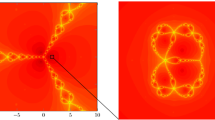Abstract
Newton’s method is a well-known iterative method to find roots of a function. The related Newton maps have primarily been studied for polynomials, but recently extended to rational and transcendental functions. We describe how a rational function r influences the degree and fixed points of its Newton map R. We then analyze the Julia sets of the Newton maps of Möbius transformations. In doing so, we verify a conjecture of Corte and expand on that result. We also consider Newton maps of rational functions of the form \(\displaystyle \frac{(z-r_1)(z-r_2)}{z-p}\). We prove that these Newton maps are all conjugate to \(z^2\), allowing us to completely describe their Julia sets.
Similar content being viewed by others
References
Baker, I.N. 1964. Fixpoints of polynomials and rational functions. J. London Math. Soc. 39 (1): 615–622. MR0169989 (30 #230).
Beardon, A.F. 2000. Iteration of rational functions. New York: Springer-Verlag.
Blanchard, P. 1994. The dynamics of Newton’s method, (Complex dynamical systems, Cincinnati, OH, 1994), Proc. Sympos. Appl. Math., 49, Amer. Math. Soc., Providence, RI, 139–154, MR1315536
Bridger, M. 1988. Looking at the Mandelbrot set. College Math. J. 19 (4): 353–363. MR0962486.
Brolin, H. 1965. Invariant sets under iteration of rational functions. Ark. Mat. 6 (2): 103–144. MR0194595 (33 #2805).
Buff, X., and C. Henriksen. 2003. On König’s root-finding algorithms. Nonlinearity 16: 989–1015.
Cayley, M.A. 1879. Application of the Newton-Fourier method to the imaginary root of an equation. Quart. J. Math. 16: 179–185.
Cayley, M.A. 1879. The Newton-Fourier imaginary problem. Amer. J. Math. 2: 97.
Cayley, M.A. 1980. On the Newton-Fourier imaginary problem. Proc. Cambridge Phil. Soc. 3: 231–232.
Corte, J. Fractal images generated by Newton’s method, MS Thesis, University of Tennessee, Knoxville, 2003.
Dwyer, J., R.W. Barnard, D. Cook, and J. Corte. 2009. Iteration of complex functions and Newton’s method. Austral. Sen. Math. J. 23 (1): 9–16.
Haeseler, F.V., and H.-O. Peitgen. 1988. Newton’s method and complex dynamical systems. Acta Appl. Math. 13 (1–2): 3–58. MR0979816 (90a:58102).
Author information
Authors and Affiliations
Corresponding author
Ethics declarations
Conflict of interest
Roger W. Barnard declares that he has no conflict of interest. Jerry Dwyer declares that he has no conflict of interest. Erin Williams declares that she has no conflict of interest. G. Brock Williams declares that he has no conflict of interest.
Ethical approval
This article does not contain any studies with human participants or animals performed by any of the authors.
Additional information
Communicated by Samy Ponnusamy.
Publisher's Note
Springer Nature remains neutral with regard to jurisdictional claims in published maps and institutional affiliations.
Rights and permissions
About this article
Cite this article
Barnard, R.W., Dwyer, J., Williams, E. et al. Dynamics of the Newton maps of rational functions. J Anal 29, 1055–1070 (2021). https://doi.org/10.1007/s41478-021-00304-x
Received:
Accepted:
Published:
Issue Date:
DOI: https://doi.org/10.1007/s41478-021-00304-x




